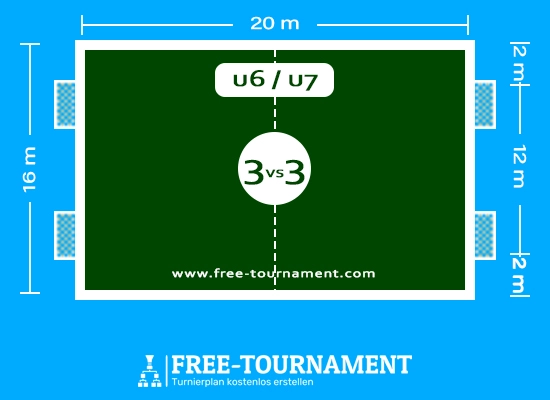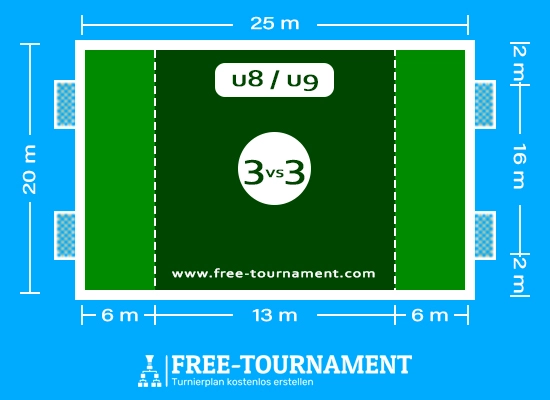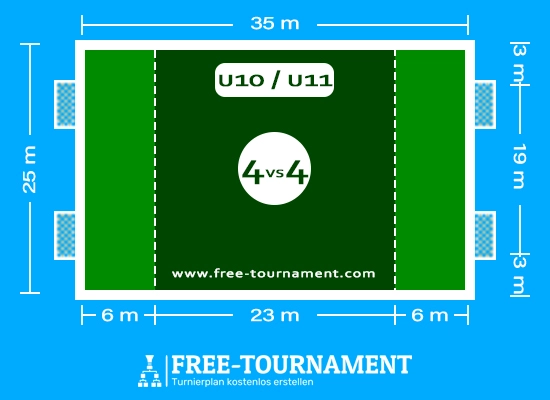Create an online match schedule for your Funino matchday
Funino scheduleWhat is Funino? Field sizes and rules explained briefly!
Field size for Funino U6 and U7

The Funino field for U6 and U7 age groups measures 20 meters in length and 16 meters in width. It is played in a dynamic 2 vs 2 or 3 vs 3 format.
Each goal line has two mini-goals, positioned 2 meters away from the sideline. A special feature in this age group: the midfield line serves as a shooting zone, meaning goals can only be scored from this line onwards.
The small field and few players create an intense, contact-rich game that promotes ball control, dribbling skills, and game intelligence in children.
Each goal line has two mini-goals, positioned 2 meters away from the sideline. A special feature in this age group: the midfield line serves as a shooting zone, meaning goals can only be scored from this line onwards.
The small field and few players create an intense, contact-rich game that promotes ball control, dribbling skills, and game intelligence in children.
Field size for Funino U8 and U9

The Funino field for U8 and U9 age groups is 25 meters long and 20 meters wide. It is played intensively in a 3 vs 3 format, with two mini-goals on each goal line, 2 meters from the sidelines.
Each half contains a shooting zone 6 meters from the goal line. Goals can only be scored from within this zone, encouraging precise dribbling and targeted finishes.
With a slightly larger field and dynamic positioning, a fast-paced game with many ball contacts is created, optimally developing children's technique and game intelligence.
Each half contains a shooting zone 6 meters from the goal line. Goals can only be scored from within this zone, encouraging precise dribbling and targeted finishes.
With a slightly larger field and dynamic positioning, a fast-paced game with many ball contacts is created, optimally developing children's technique and game intelligence.
Field size for Funino U10 and U11

The Funino field for U10 and U11 age groups measures between 30 and 35 meters in length and 25 meters in width, making it larger than for younger age groups. It is played in a 4 vs 4 format, with two mini-goals on each goal line, 3 meters from the sidelines.
Each half contains a shooting zone starting 6 meters in front of the goal line. Goals can only be scored within this zone, encouraging precise passing, controlled dribbling, and targeted finishes.
With larger dimensions and more players, a fast-paced, tactically demanding game with many ball contacts is created, further developing technique, game intelligence, and teamwork in older children.
Each half contains a shooting zone starting 6 meters in front of the goal line. Goals can only be scored within this zone, encouraging precise passing, controlled dribbling, and targeted finishes.
With larger dimensions and more players, a fast-paced, tactically demanding game with many ball contacts is created, further developing technique, game intelligence, and teamwork in older children.
Funino rules
- 1 Game start
- All players start at their own goal line and sprint to the ball in the middle.
- 2 Sideline out
- The ball is dribbled or passed in. A direct shot is allowed. Important: The ball must be on the line, and the player must not gain an unfair advantage with a quick run-up.
- 3 Goal line out
- The game resumes with a dribble or pass from the goal line. No attacking player may be in the shooting zone.
- 4 Corner kick
- Instead of a traditional corner kick, the ball is dribbled or passed in from a marker cone in the shooting zone. The same applies if the ball goes out of play in the shooting zone.
- 5 Distance & substitutions
- For throw-ins, corner kicks, and rule violations, opponents must maintain a minimum distance of 3 meters. Substitutions occur only in the substitution zone at midfield.
- 6 Goal scoring
- After a goal, play resumes with a dribble-in from the goal line. No opponent may be in the shooting zone.
- 7 Fairness rule for big leads
- If a team leads by 3 goals, the trailing team receives an additional field player (4 vs 3 or 6 vs 5). If the trailing team has no substitutes, the leading team removes a player (2 vs 3 or 4 vs 5). This rule also applies to matches with goalkeepers on youth goals.
- 8 Foul or goal prevention in the shooting zone
- In the event of a serious foul or rule violation by defenders in the shooting zone, a penalty attack is awarded.
Procedure: An attacker starts with the ball from the midfield line. A defender stands in their own shooting zone. All other players start behind the attacker at the goal line. As soon as the attacker moves, all players can join in. - 9 Fair play mode
- There is no referee – players decide fairly themselves. Parents must stay 15 meters away and not coach. Coaches stand together on the sideline, intervene minimally, and ensure fair substitutions.
- 10 No pressure to win
- There is no point table or award ceremony. The focus is on player development and enjoyment of the game.
- 11 Goalkeeper rule (if playing with goalkeepers on youth goals):
- The goalkeeper should be actively involved in play. No goal kicks or throws over the midfield line. Back passes should not be picked up with hands. If they are: No foul, but coaching improvement.
How was Funino created and why is it good for children?
Funino – the name says it all: "Fun" stands for enjoyment and "Niño" for child. This special playing style was developed in 1990 by Horst Wein to give young footballers more fun and ball contacts. Unlike traditional 7 vs 7 football, smaller teams (often 3 vs 3 or 4 vs 4) play without fixed positions or even goalkeepers.
Funino is played with four mini-goals. After each goal, the teams rotate so that all children get regular playing time and no one has to sit on the bench. The field and game times are age-appropriate, resulting in short, intense matches.
Funino ensures that more children actively have the ball, improve their technique, and most importantly, experience the joy of the game. This new format is a key part of the national reform in children's football, which will become mandatory in Germany from the 2024/2025 season – bringing more fun, success, and ultimately more young players into football.
Funino is played with four mini-goals. After each goal, the teams rotate so that all children get regular playing time and no one has to sit on the bench. The field and game times are age-appropriate, resulting in short, intense matches.
Funino ensures that more children actively have the ball, improve their technique, and most importantly, experience the joy of the game. This new format is a key part of the national reform in children's football, which will become mandatory in Germany from the 2024/2025 season – bringing more fun, success, and ultimately more young players into football.
Benefits of Funino
- More ball contacts, improving football technique and game intelligence.
- All children are actively involved, so no one has to sit on the bench.
- The field size and game duration are adapted to the age, leading to shorter, more intense matches.